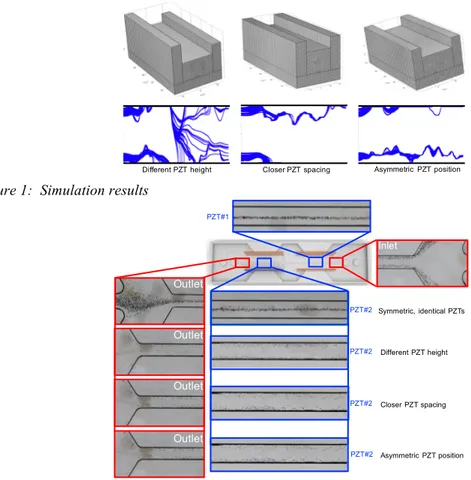3D MODELING OF ON-CHIP ACOUSTOPHORETIC PARTICLE
MANIPULATION IN A POLYMER MICROFLUIDIC DEVICE
E. Çağatay
1, M. B. Özer
1, and B. Çetin
21
Dept. Mech. Eng., TOBB Uni. Science & Technology, Ankara, Turkey and
2
Microfluidics & Lab-on-a-chip Research Group, İ.D. Bilkent Uni., Ankara, Turkey
ABSTRACT
This study focuses on understanding of the sensitivities of the acoustophoretic process on uncertainties/errors in the geometric properties of the chip material and the piezoelectric actuators. The sensitivity of the acoustophoretic process is investigated both numerically and experimentally. For the numerical simulations a three dimensional finite element model is used. In the experimental analysis, a microfluidic chip with two stations is used. The first station has the accurate geometric values of the design and the second station has the introduced error in a geometric parameter so that the effect of this error can be demonstrated on the same chip and the channel.
KEYWORDS: Microfluidics, Particle manipulation, Acoustophoresis INTRODUCTION
Acoustophoresis is the process of separation of particles/cells using acoustic radiation force. In micro-channels, this process is performed using piezoelectric materials for ultrasonic wave generation and these induced waves create a resonance condition along the channel cross-section1. The purpose of this study is to investigate sensitivities of the acoustophoresis process in polymer chip materials. This investigation is performed both numerically and experimentally.
THEORY
For effective separation, the resonance frequency of the piezoelectric actuators (PZTs) along the actuation direction should coincide with the resonance frequency of the acoustic waves along the channel cross-section which makes the separation process sensitive to geometric and dynamic design parameter variations. This is even more critical, if the chip material is a highly damped material (polymer materials such as PDMS) which decreases the pressure amplitudes of the standing waves. Therefore, it is important for the system to be tuned with the correct geometric parameters.
Numerical modeling enables one to estimate the correct values of the parameters which would result in a correctly tuned resonant system. Unlike many studies in literature, in this study a 3D finite element model which includes the dynamics of PZTs is used2. The numerical model couples the electro-mechanical, acoustic and fluidic domains, therefore enables one to investigate the importance of parameters such as piezoelectric material location. Numerical simulation calculates the acoustic response inside the microfluidic channel and calculates the acoustic radiation force on each micro-particle based on point-micro-particle approach3.
EXPERIMENTAL
The fabrication of the mold which includes notches for the precise positioning of the PZTs is performed by high precision machining. The experimental setup consists of a laboratory syringe pump (New Era Pump Systems-NE 300), a function generators (Agilent 33250A), an amplifier (Falco Systems WMA-300), an inverted optical microscope (lMIT-inv, AIV Labs), glass syringes and tubing. A buffer solution in which 5µm diameter latex particles are suspended in a deionized (DI) water solution. Particle solution (2 µL/min) is loaded from the side inlets and DI water (10 µL/min) is loaded from the main inlet. The PZTs are operated at 39.8Vpp and 2.23MHz. Two different stations are introduced. The first station is for control and optimal parameters are used to obtain a successful manipulation of the particles (successful manipulation refers to the focusing of the particles at the mid-channel). In the second station, cases with uncertainties/errors which lead to unsuccessful manipulation are generated.
Different PZT height Closer PZT spacing Asymmetric PZT position
Figure 1: Simulation results
Inlet Outlet PZT#1 PZT#2 PZT#2 PZT#2 PZT#2 Outlet Outlet Outlet Different PZT height Closer PZT spacing Asymmetric PZT position Symmetric, identical PZTs
Figure 2: Experimental results.
RESULTS AND DISCUSSION
The first investigated case is the effect of having one of the PZTs with a different height than the other one. The other case focuses on the effect of having the channel walls closer to one PZTs. The third case is to investigate the effect of having less than optimal distance in between the PZTs. As seen from the figures, the cases with uncertainties/errors lead to unsuccessful manipulation, and the prediction of the simulations are good agreement with the experiments. 3D finite element numerical tool developed in this study was accurate in demonstrating the effects of different design parameters on particle trajectories. A numerical model which does not include 3D effects cannot predict the particle trajectories.
CONCLUSION
This study helped us to conclude that in acoustophoresis, unlike silicon or glass based microfluidic devices, there exists high sensitivity to asymmetries in the PZT and chip geometric properties when the polymeric devices are considered.
REFERENCES
[1] B. Cetin, M. B. Ozer, M. B., M. E. Solmaz, “Microfluidic bio-particle manipulation for biotech-nology,” Biochem. Eng. J., 92, 63-82, 2014.
[2] B. Cetin, M. B. Ozer , E. Cagatay, S. Buyukkocak, “An integrated acoustic and dielectrophoretic particle manipulation in a microfluidic device for particle wash and separation fabricated by me-chanical machining,” Biomicrofluidics, 10, 014112, 2016.
[3] S. Buyukkocak, M. B. Ozer, B. Cetin, “Numerical modeling of acoustophoretic particle separa-tion for microfuildics,” Microfluid Nanofluid, 17, 1025-1037, 2014.
CONTACT
